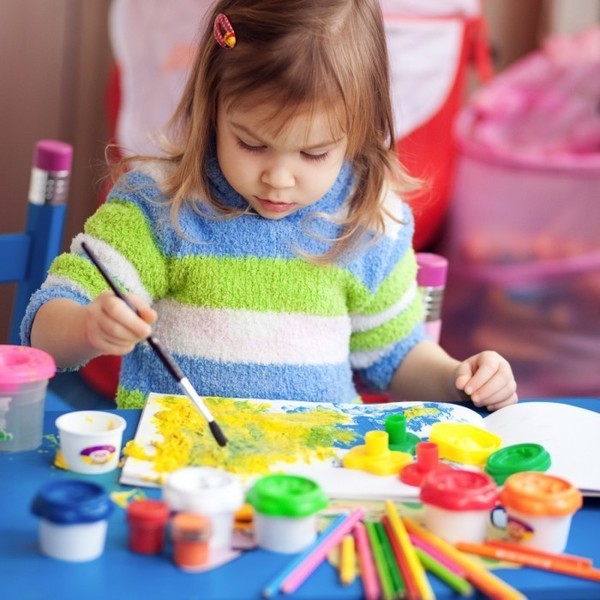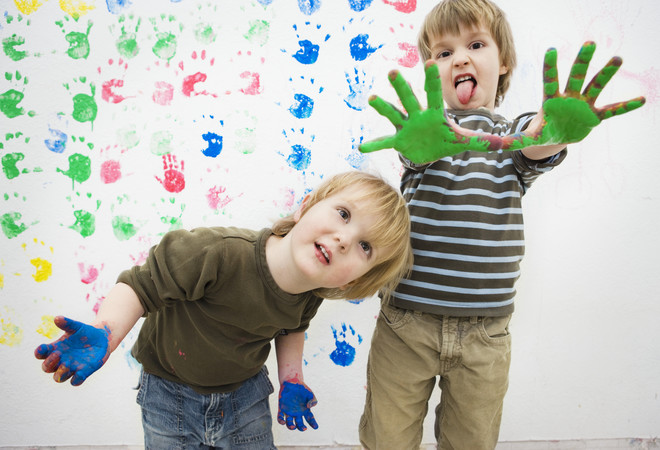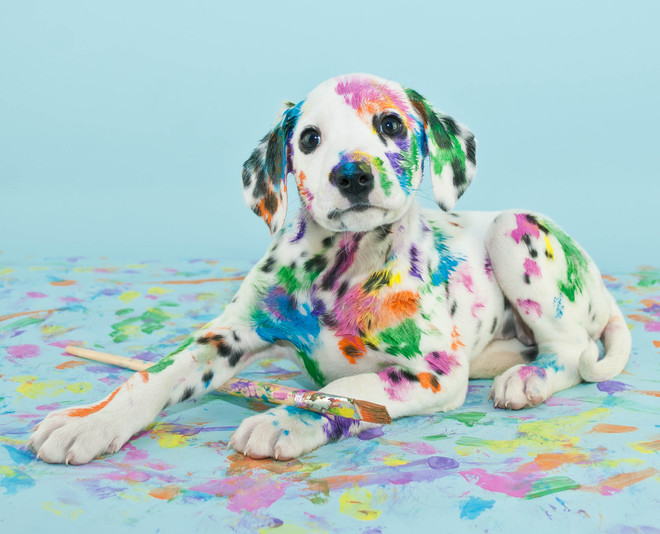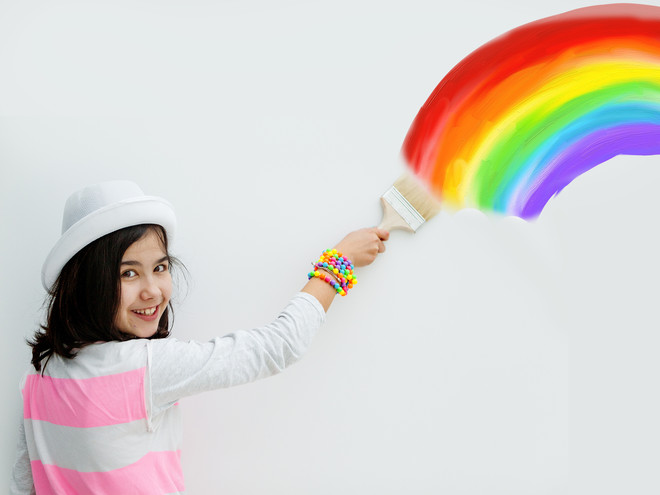First of all, we will make a reservation: do not rush into panic, seeing gloomy tones on the drawing, noting the systematic absence of one or another member of the family in the pictures. "I'm just too lazy to draw it," Timofei explained, why there are no places for my grandmother in his drawings. And the mother's heart is already in a grief: does the grandmother have a conflict with her grandson? The favorite color of the child appears for three years already. And most clearly his color preferences are manifested in the senior preschool and junior school age. The fact is that when a child draws, the rational goes to the background, the prohibitions and restrictions recede. And the baby depicts what his soul asks. And that's what she asks, attentive parents will be prompted by the colors of the drawing. And how to decipher them, we will now prompt. Photo: firestock
Photo: firestock
There are nuances
First things first – felt-tip pens.Or pencils, paints, crayons or any other media your child draws with. Pay attention to them - maybe he just ran out of green, so the grass and trees are now red. The set should be complete. Freedom of creativity, after all. The second nuance - do not try to decipher each color that appears on the paper. Consider only the predominant one. And the predominant one not only in today's drawing, but in general - over the past week, month. Third - pay attention to what exactly the child draws. Some themes of drawings, for example, a forest or a sea, in themselves determine the color. Green grass is not a reason for a diagnosis. But if the child persistently colors the sky, and the sea, and the grass, and people purple, you can pay attention to this. But do not forget about the first point. By the way, psychologists mainly use three themes for analysis: a person, a family, an imaginary animal. If the child draws his family, then pay attention to what color individual figures are drawn. Black dad, green grandma - this can be an artistic expression of the child's attitude to a person. The key is - can be. Do not rush to arrange a showdown out of thin air. Well, and the color the child drew himself with will tell how the child perceives himself, how he feels. Pay attention to how many colors the child uses. Children 4-7 years old with a normal level of emotional development use 5-6 colors. If the child draws with only one or two pencils, then this may indicate a negative emotional state. It is not very good if the child prefers only a simple pencil. Psychologists believe that this means a lack of bright events and positive emotions in the child's life. Photo: GettyImages
Photo: GettyImages
Every hunter wants to know...
RedThe color of life and energy.But many psychologists consider this color to be aggressive. Children who often paint in red are quite open to society, they are very active, energetic, emotional. Often, lovers of red are characterized by egoism and leadership qualities - the latter can be seized upon and developed. If a usually modest child began to choose the color red, this may mean that he is tense and close to becoming aggressive. Just let the baby rest. Orange It means a desire for bright impressions, curiosity and interest in life. It is chosen by open, sociable, cheerful, spontaneous children who often change their opinions and hobbies. They are often hot-tempered and whiny, naughty and fool around - not because they are ill-mannered, but simply because they are like that. They definitely need to find an activity that will give an outlet for their energy, active sports would be ideal. Pink Fans of pink require increased attention, they vitally need a sense of security. Very often, timid children love pink. So if your child is "rosy", know: support from family and friends is very important to him, they are dependent on the opinions of others. Praise him, encourage, hug and tell him how much you love him, so that the baby understands how much he means to you. However, this will not hurt anyone. YellowThis color is preferred by dreamy children. They have a well-developed imagination, leadership qualities, but at the same time they can be irresponsible. Psychologists believe that if a child chooses yellow, he feels comfortable in his environment. This means that everything is fine, and you can work on developing their dreaminess: a romantic baby is created for a creative profession. For example, an architect, animator, designer or researcher. GreenCongratulations: your child has a high intellect and a developed imagination. But not only that. Green in children's drawings usually also means that the baby feels lonely, he lacks attention from his parents. If the situation does not change, the child will grow up withdrawn, secretive, afraid of any changes, apathetic. So spend more time with your child, even if you think that you already pay too much attention to your baby. A photo: GettyImagesBeautiful, who sees the world in heavenly tones, are friendly, friendly, easy to make new acquaintances, but at the same time are quite serious compared to other children. Such babies are prone to reverie and are very attentive to the details of events around him. So do not throw words with him to the wind: he will hear everything, ponder and draw conclusions. After all, a small analyst is growing near you. And who knows, maybe, and a great scientist. The blue color of balanced and slightly phlegmatic children. Such children prefer quiet and quiet games. But even the children-donkeys sometimes start to paint only in blue. This can mean that the child is tired of noisy games and wants to just remain in peace and quiet. Give him this opportunity, because each of us sometimes need to be alone with himself. Deficiency of personal space is a terrible thing. Gray This color is drawn by quiet and self-contained children. They constantly need the support of adults. "Gray" situation occurs when the child was fenced off or he himself was fenced off from other children. Give your child more attention so that their gray drawings are painted with all the colors of the rainbow. Otherwise, there is a possibility that you will grow a "little man in a case", which simply can not be pulled out of the eternal depression. Brown Children who prefer brown in their drawings live in their own world, often do not want to let anyone in there. There are many causes of "brown" discomfort: poor health, family troubles, participation in dramatic events. Try to look from the side to the position of the child in the family: maybe he hears your quarrels? Or are you pouring negative on others, coming from a hated work?
A photo: GettyImagesBeautiful, who sees the world in heavenly tones, are friendly, friendly, easy to make new acquaintances, but at the same time are quite serious compared to other children. Such babies are prone to reverie and are very attentive to the details of events around him. So do not throw words with him to the wind: he will hear everything, ponder and draw conclusions. After all, a small analyst is growing near you. And who knows, maybe, and a great scientist. The blue color of balanced and slightly phlegmatic children. Such children prefer quiet and quiet games. But even the children-donkeys sometimes start to paint only in blue. This can mean that the child is tired of noisy games and wants to just remain in peace and quiet. Give him this opportunity, because each of us sometimes need to be alone with himself. Deficiency of personal space is a terrible thing. Gray This color is drawn by quiet and self-contained children. They constantly need the support of adults. "Gray" situation occurs when the child was fenced off or he himself was fenced off from other children. Give your child more attention so that their gray drawings are painted with all the colors of the rainbow. Otherwise, there is a possibility that you will grow a "little man in a case", which simply can not be pulled out of the eternal depression. Brown Children who prefer brown in their drawings live in their own world, often do not want to let anyone in there. There are many causes of "brown" discomfort: poor health, family troubles, participation in dramatic events. Try to look from the side to the position of the child in the family: maybe he hears your quarrels? Or are you pouring negative on others, coming from a hated work? Photo:GettyImagesBlack Perhaps the biggest concern for parents is the appearance of black in children's drawings. And for good reason, because it means depression, hostility, protest and a sense of hopelessness. If black has become the predominant color in your child's drawings and he has been drawing like this for quite a long time, then you should consult a psychologist. A specialist will better determine whether it is worth sounding the alarm, or whether nothing terrible is happening to your child, he is just a fan of the graphic genre in art. P.S. And let us remind you: analyzing a drawing is not as easy as it seems. You need to interpret not one picture, but a whole series. It is even better for the child to explain why he sees the world this way and not differently. Otherwise, it happens that they begin to look for a problem where there is none and never was one. Therefore, if you have any suspicions, contact a professional child psychologist. He will help you figure everything out.
Photo:GettyImagesBlack Perhaps the biggest concern for parents is the appearance of black in children's drawings. And for good reason, because it means depression, hostility, protest and a sense of hopelessness. If black has become the predominant color in your child's drawings and he has been drawing like this for quite a long time, then you should consult a psychologist. A specialist will better determine whether it is worth sounding the alarm, or whether nothing terrible is happening to your child, he is just a fan of the graphic genre in art. P.S. And let us remind you: analyzing a drawing is not as easy as it seems. You need to interpret not one picture, but a whole series. It is even better for the child to explain why he sees the world this way and not differently. Otherwise, it happens that they begin to look for a problem where there is none and never was one. Therefore, if you have any suspicions, contact a professional child psychologist. He will help you figure everything out.









